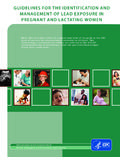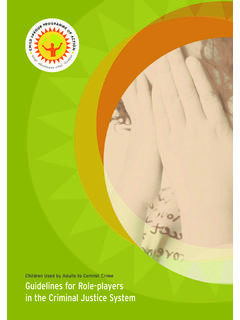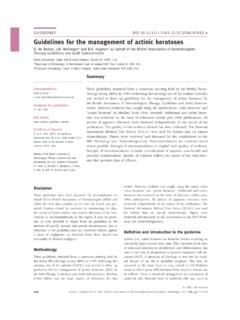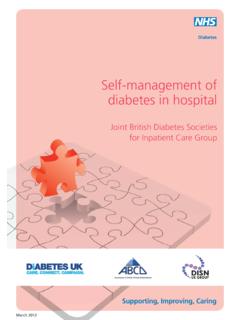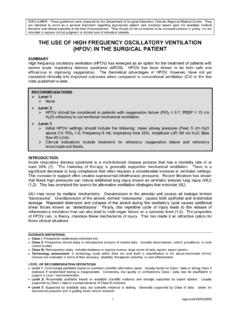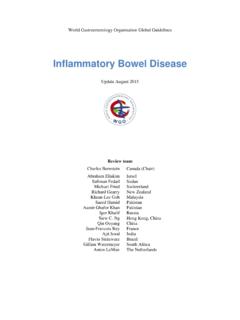Transcription of Medical Management Guidelines for Lead-Exposed Adults ...
1 Medical Management Guidelines for Lead-Exposed Adults Revised 04/24/2007 Summary: Overexposure to inorganic lead continues to be an important problem worldwide. The reduction of lead in the environment, largely accomplished through effective EPA regulatory efforts, has resulted in lowering the overall geometric mean whole blood lead level (BLL) for the general population in the United States from approximately 13 g/dL ( mol/L) in the 1970s to less than 2 g/dL ( mol/L) (CDC 2005; NCHS 1984). Lead exposure remains a significant public health and Medical concern for thousands of children and Adults exposed primarily through remaining lead-based paint in older housing stock as well as to workplace exposures, although other sources occur. For children and Adults , the role of environmental investigation, identification and reduction or elimination of sources of exposure remains of primary importance. While the clinical care of Lead-Exposed children has been well established in the pediatric and public health communities, similar clinical recommendations for Adults have not been widely available.
2 The purpose of this document is to provide useful advice to clinicians caring for adult patients who have been exposed to lead, whether at work, at home, through hobbies, in the community, through consumer products, retained bullets, or other sources. This document is derived, in part, from the input of an expert panel convened by the Association of Occupational and Environmental Clinics (AOEC). However, three clinical scholars then considered the Medical evidence submitted by the expert panel and incorporated many of the conclusions reached by this panel. This paper, therefore, reflects a general consensus of the clinical views of AOEC members, not necessarily the expert panel, particularly in areas where the expert panel had been unable to come to consensus. The following points are emphasized: 1) Medical care serves as an adjunct to public health and industrial hygiene exposure control. Clinicians who evaluate patients with potential lead exposure should have appropriate referral mechanisms in place for prevention of further exposure to lead.
3 Although one goal of health care is to remove the patient from exposure, the social consequences of potential disruption of housing or of income may be important and must be considered by the clinician. 2) Current occupational standards are not sufficiently protective and should be strengthened. Although the federal Occupational Safety and Health Administration s (OSHA) lead standards have provided guidance that has been beneficial for Lead-Exposed workers, these regulations have not been substantially changed since the late 1970s and thus are primarily based on health effects studies that are well over three decades old. There is an urgent need to revise them. 3) The clinical Guidelines presented here are appropriate for Adults , recognizing that younger Adults , particularly those in workplace settings, may share developmental risks that place them closer to pediatric populations, and that maternal exposure, whether in the workplace or in the general environment, places the developing fetus at risk for exposure.
4 1 4) Clinicians should feel free to contact any of the member AOEC clinics for additional telephone advice, and are encouraged to refer patients when appropriate. Background Lead is used in over 100 industries. Job activities known to involve the use or disturbance of lead include: handling of lead-containing powders, liquids, or pastes; production of dust or fumes by melting, burning, cutting, drilling, machining, sanding, scraping, grinding, polishing, etching, blasting, torching, or welding lead-containing solids; and dry sweeping of lead-containing dust and debris. Adults also encounter lead in environmental settings and through activities such as home remodeling, particularly in homes built before 1978 that contain lead-based paint, lead-contaminated consumer products, traditional remedies, moonshine whiskey, hobbies, such as melting lead sinkers or use of target ranges, from retained bullets, and through other sources. Lead is not an essential element and serves no useful purpose in the body.
5 A substantial body of recent research demonstrates that multiple health effects can occur at levels once considered safe. The routes of exposure for inorganic lead are inhalation and ingestion. Once absorbed, lead is found in all tissues, but eventually 90% or more of the body burden is accumulated (or redistributed) into bone with a biological half-life of years to decades. Lead is excreted primarily in the urine. Lead does not remain in the bone permanently but is slowly released back into the blood. The dose or quantity of lead that a person receives will be determined by the concentration of lead in the air and/or the amount ingested as well as the duration of such exposure. The BLL remains the predominant biological marker used in clinical assessment, workplace monitoring, public health surveillance, and regulatory decisions regarding removal from exposure under the OSHA lead standards. Research tools capable of measuring cumulative lead exposure, such as the use of in-vivo K-shell X-ray fluorescence (K-XRF) instruments for the rapid, non-invasive measurement of lead in bone, have expanded recent understanding of long-term consequences from lead exposure on a population basis.
6 These studies have demonstrated adverse effects of lead exposure across populations, including on neurologic, reproductive and renal function and on blood pressure, that occur at extremely low levels of exposure and appear not to have a threshold. However, because inter-individual differences are greater than population differences at lower lead levels, these effects are less important for clinical evaluation than they are for public health policy. The preponderance of the evidence for adverse effects at levels of exposure far below those currently permitted by OSHA speaks forcefully for an immediate reduction in permissible exposure levels in the workplace and for enhanced public health attention to those sources, including among self employed individuals, not currently subject to OSHA regulation. 2 Because lead interferes with biochemical processes occurring in cells throughout the body, adverse effects occur in multiple organ systems. The non-uniformity of symptoms that appear in exposed individuals, as well as a growing body of epidemiologic studies, suggest that wide variation exists in individual susceptibility to lead poisoning.
7 Early overt symptoms in Adults are often subtle and nonspecific, involving the nervous, gastrointestinal, or musculoskeletal systems. High levels of exposure can result in delirium, seizures, stupor, coma, or lead colic. Other overt signs and symptoms include hypertension, peripheral neuropathy, ataxia, tremor, gout, nephropathy, and anemia. In general, symptoms increase with increasing BLLs. In addition to exposure that occurs from external sources, carefully performed lead isotope studies demonstrated that pregnancy and lactation are both associated with large increases in the release of lead from the maternal skeleton (Gulson et al. 2003). High levels of lead in women s bones at the time of childbirth corresponded to lower birth weight (Gonzalez-Cossio et al. 1997), lower weight gain from birth to one month of age (Sanin et al. 2001), and reduced head circumference and birth length (Hernandez-Avila et al. 2002). In males, abnormal sperm morphology and decreased sperm count have been observed at BLLs of approximately 40 g/dL ( mol/L) or less (Telisman et al.)
8 2000). In the absence of effects on sperm count or concentration, the impact of paternal lead exposure on reproductive outcome is uncertain. Recent research has examined several genetic polymorphisms that may influence lead uptake, distribution, and target organ toxicity. However, at this point in time, research findings are insufficient to conclusively identify subpopulations that may have increased susceptibility to lead toxicity based on specific genotypes. Other factors that might modify the risk of lead toxicity include pre-existing disease affecting relevant target organs (such as diabetic nephropathy or borderline hypertension), nutritional deficiencies (particularly of dietary cations such as iron and calcium), ethnicity, and aging. CLINICAL ASSESSMENT OF LEAD EXPOSURE Taking a detailed Medical and occupational/environmental history is a fundamental step in the assessment of a person with lead exposure. It is important to ask about exposure to lead in current and previous jobs (Table 1), protections used, biological and air monitoring data, hygiene practices, knowledge and training, hobbies, traditional medications, moonshine use and other non-occupational sources (Table 2).
9 A Medical and reproductive history is essential in identifying individuals at increased risk of adverse health effects from lead exposure. Table 3 summarizes symptoms and target organ toxicity of lead at progressive BLLs. Physical exam findings in lead poisoning are frequently lacking. Gingival lead lines and wrist or foot drop are rarely seen. Blood Lead Level and Zinc Protoporphyrin 3 The BLL is the most convenient and readily interpretable of the available lead biomarkers. It is mainly an estimate of recent external exposure to lead, but it is also in equilibrium with bone lead stores. The BLL alone is not a reliable indicator of prior or cumulative dose or total body burden; nor can a single BLL be used to confirm or deny the presence of chronic health effects thought due to lead exposure. The normal or reference range BLL is less than 5 g/dL ( mol/L) for more than 90% (CDC 2005) of the adult population. When interpreting the BLL, key questions are whether the exposure has been 1) of short-term or long-term duration; 2) recent or in the remote past; and 3) of high or low intensity.
10 Erythrocyte protoporphyrin IX (EP), which can be measured as free EP (FEP) or zinc protoporphyrin (ZPP), is a measurement of biological effect and is an indirect reflection of lead exposure. Lead affects the heme synthesis pathway. Increases in EP or ZPP are not detectable until BLLs reach 20 to 25 g/dL, ( mol/L) followed by an exponential rise relative to increasing BLLs. An increase in EP or ZPP usually lags behind an increase in BLL by two to six weeks. Periodic testing of BLL and ZPP, called biological monitoring, is required by the OSHA lead standards for workers exposed to significant levels of airborne lead. Other Laboratory Tests Depending on the magnitude of lead exposure, a complete blood count, serum creatinine, blood urea nitrogen, and complete urinalysis may be indicated. Evaluation of reproductive status may be pertinent for some Lead-Exposed Adults . It is important to check BLLs of family members, particularly children, of Lead-Exposed individuals.
